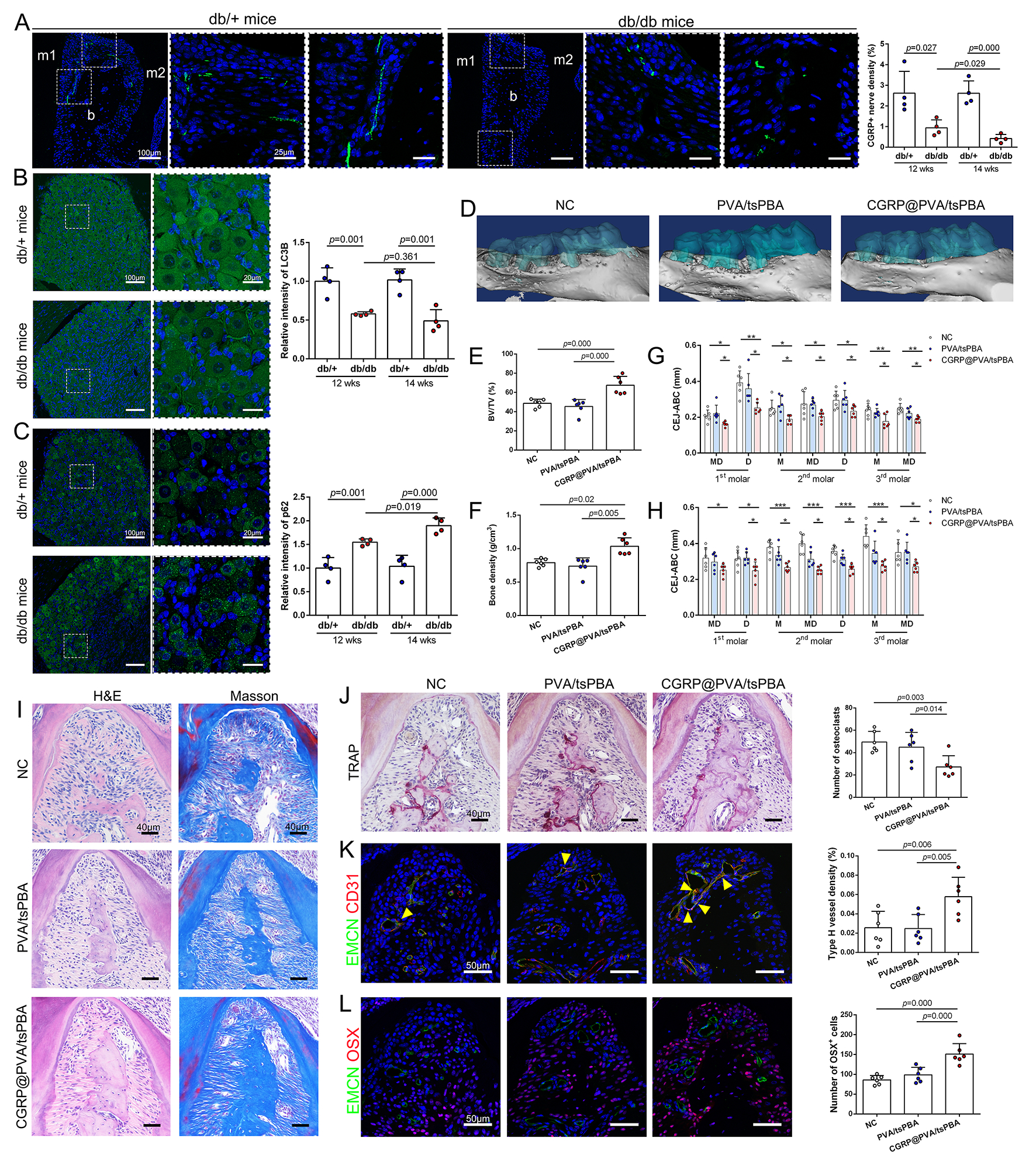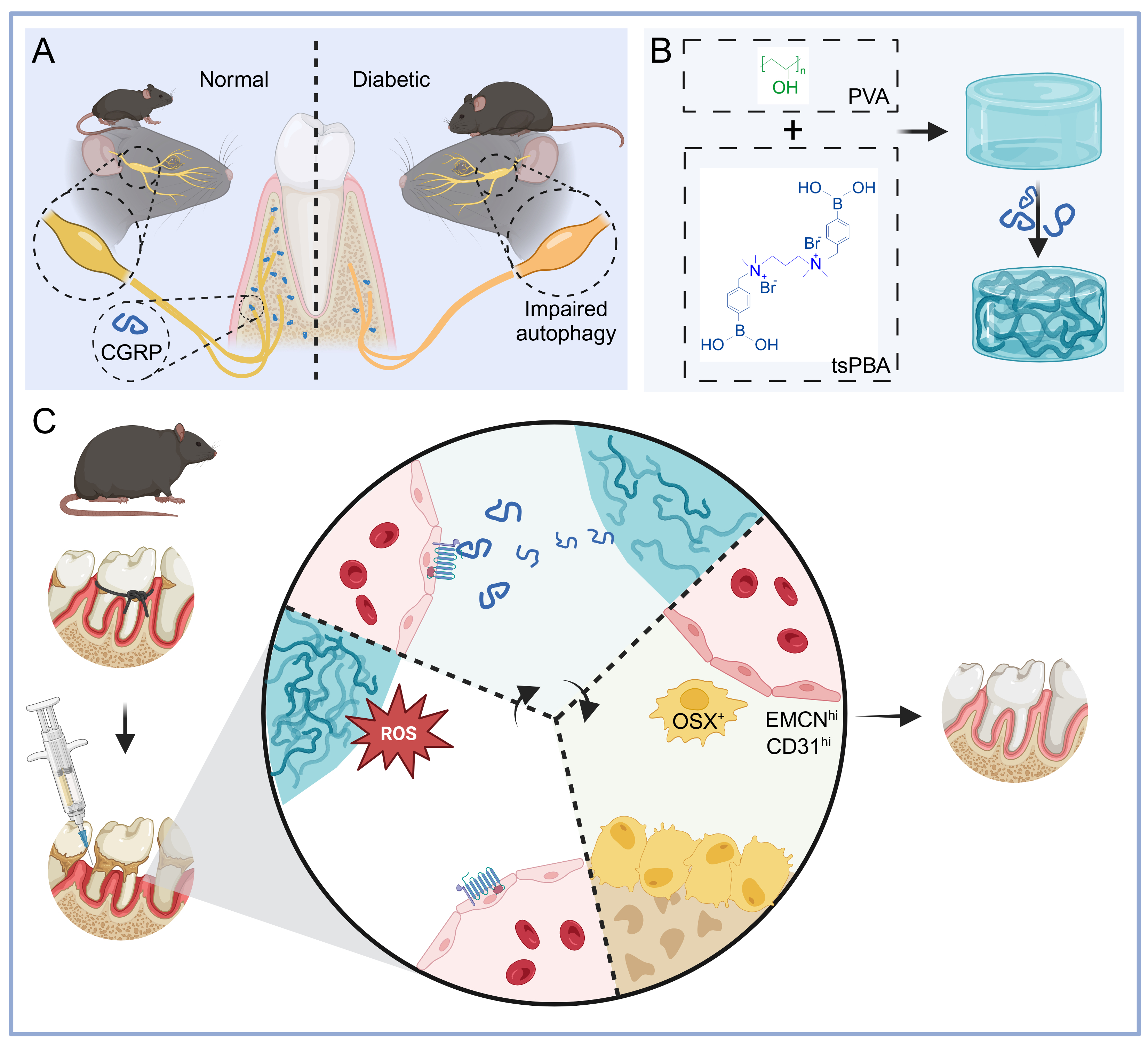IADR Abstract Archives
CGRP-Loaded Hydrogel Promotes Bone Regeneration in Diabetes-Related Periodontitis Through Angiogenesis
Objectives: Diabetes as a major risk factor exacerbates the progression of periodontitis. This study attempted to identify potential therapeutic targets and strategies for enhancing periodontal regeneration by modulating the neural microenvironment in diabetes-related periodontitis.
Methods: Diabetes-related periodontitis was induced by tying silks around the molars of db/db mice. Neural changes in periodontium and trigeminal ganglia were analyzed by immunofluorescence (IF) staining, while alveolar bone was evaluated via micro-CT and histological staining. Periodontal denervated mice were obtained through inferior alveolar nerve axotomy to mimic the potential effect of diabetes on periodontal nerves. Single-cell analysis was performed to assess the cellular expression of calcitonin gene-related peptide (CGRP) receptors. Type H vessels were identified with anti-CD31 and endomucin co-IF staining. Lastly, an injectable ROS-responsive hydrogel was developed for the delivery of CGRP.
Results: Neuropathy in the periodontium was marked by peripheral nerve loss in the db/db mice, and the ganglion neurons exhibited reduced autophagy as well. Periodontal inflammation accounted for considerable bone loss in diabetic mice, which was phenocopied by denervating the periodontium. CGRP+ nerve density and CGRP expression were reduced in diabetic mice, and its distribution in periodontium declined with the progression of diabetes and inflammation. CGRP receptors were primarily expressed in gingival endothelial cells. In the mice with diabetes-related periodontitis or denervated periodontium, type H vessel density and osteoprogenitors declined significantly. Notably, the ROS-responsive hydrogel-based delivery of CGRP effectively scavenged ROS and protected CGRP against proteolysis, and yet enhanced bone regeneration via inducing type H vessel formation.
Conclusions: This study illustrates that diabetes-induced damage to sensory nerves, especially CGRP+ nerves, could exacerbate periodontal destruction by hindering type H vessel formation. The CGRP-encapsulated ROS-responsive hydrogels may be a promising therapeutic approach to enhancing periodontal regeneration in diabetes-related periodontitis.
Methods: Diabetes-related periodontitis was induced by tying silks around the molars of db/db mice. Neural changes in periodontium and trigeminal ganglia were analyzed by immunofluorescence (IF) staining, while alveolar bone was evaluated via micro-CT and histological staining. Periodontal denervated mice were obtained through inferior alveolar nerve axotomy to mimic the potential effect of diabetes on periodontal nerves. Single-cell analysis was performed to assess the cellular expression of calcitonin gene-related peptide (CGRP) receptors. Type H vessels were identified with anti-CD31 and endomucin co-IF staining. Lastly, an injectable ROS-responsive hydrogel was developed for the delivery of CGRP.
Results: Neuropathy in the periodontium was marked by peripheral nerve loss in the db/db mice, and the ganglion neurons exhibited reduced autophagy as well. Periodontal inflammation accounted for considerable bone loss in diabetic mice, which was phenocopied by denervating the periodontium. CGRP+ nerve density and CGRP expression were reduced in diabetic mice, and its distribution in periodontium declined with the progression of diabetes and inflammation. CGRP receptors were primarily expressed in gingival endothelial cells. In the mice with diabetes-related periodontitis or denervated periodontium, type H vessel density and osteoprogenitors declined significantly. Notably, the ROS-responsive hydrogel-based delivery of CGRP effectively scavenged ROS and protected CGRP against proteolysis, and yet enhanced bone regeneration via inducing type H vessel formation.
Conclusions: This study illustrates that diabetes-induced damage to sensory nerves, especially CGRP+ nerves, could exacerbate periodontal destruction by hindering type H vessel formation. The CGRP-encapsulated ROS-responsive hydrogels may be a promising therapeutic approach to enhancing periodontal regeneration in diabetes-related periodontitis.


